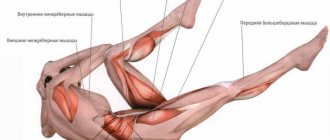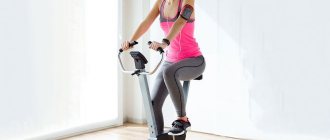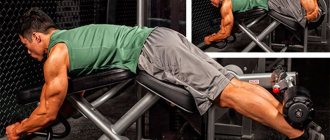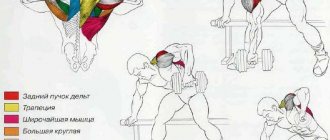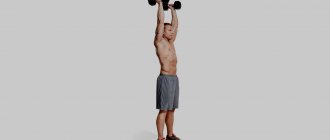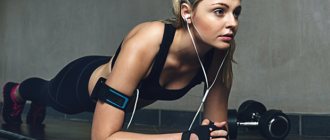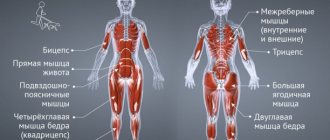About the reasons
Why do my legs hurt after squats? Among the common reasons, experienced athletes identify the following:
- The action of lactic acid - a product of physiological processes accumulates in the structures of muscle fibers. Usually, leaching of the substance from tissues is observed within 24 hours. The concentration of lactic acid in the body poses absolutely no health hazard.
- The delayed effect of microtraumas of muscle fibers - ruptures of muscle bundles after increased loads are a completely natural process. This is how tissue mass increases. In some cases, the phenomenon provokes increased production of hormones responsible for the removal of toxins and restoration of the body. The consequence is the development of pain.
- Increased muscle reactivity - heavy, uncharacteristic loads for humans lead to an imbalance of biologically active substances in bodily fluids. The result is the occurrence of convulsive conditions.
- Excessive amount of training - legs often hurt after squats, if exercises to pump up local muscles are performed daily. In this case, there is a nitrogen imbalance, the consumption of more protein relative to the amount received.
- A high range of motion - adding variety to a standard exercise - often leads to severe pain in the legs after squats. The result is stress on small muscles, which are rarely used in everyday life. The response is bound to be a feeling of discomfort.
- Trauma to the extremities - the presence of damage will be indicated by the constraining movement, aching nature of the pain. Often the consequence of trouble is the formation of swelling.
- Failure to comply with the correct exercise technique – the feeling of pain is often caused by making mistakes during training and using inappropriate loads.
Types of squats and muscle training
Squats are divided into three main options:
- powerlifting;
- weightlifting;
- bodybuilding.
You need to understand which muscles work during different types of squats. Weightlifting squats are the deepest and therefore the most difficult to perform. They involve using a large number of muscles and applying maximum effort. These exercises should be performed as deeply as possible.
Powerlifting squats are done to parallel , and sometimes a little lower. They extremely actively use the gluteal muscles. Bodybuilding squats are done slightly above parallel, and they work the thighs to a greater extent. Powerlifting squats are best for beginners.
Those whose main goal is to build muscle mass are interested in what muscles are involved when squatting with a barbell. It allows you to increase the load, and especially carefully works the quadriceps and buttock muscles, as well as the hip adductors and soleus muscles that help them. The hamstrings, abs, calves, and back extensors also work as assistants and stabilizers. In order to increase muscle mass, experts advise performing the exercise at an intense pace and with heavy weights.
Among the variety of types of squats, plie , especially among women. This exercise belongs to the isolating group. In the question of which muscles work when squatting in women, in this case we note the work of the buttocks, hamstrings, as well as the inner thigh, which is very problematic for many. It is recommended to use dumbbells for this exercise. The bar doesn't go well with it.
Keep in mind that this type of squat is not natural from an anatomical point of view, since when performing it, the load from the quadriceps moves to the buttocks and hamstrings. But this is what makes the exercise effective for a specific set of goals.
In addition to the buttocks and thighs, this exercise involves the soleus muscle , which is responsible for supporting the athlete. The load on other muscles is almost completely removed thanks to the use of dumbbells. The biceps also work to a small extent, since we hold dumbbells in our hands, but the spine is unloaded, which is extremely important for this exercise. The knee joint also takes part in the work. Now it’s clear which muscle group is affected by squats of this nature.
The answers to the question of which muscles swing when squatting for girls and men are not too different. To a large extent, it all depends on the goals pursued by the practitioner and on the muscle groups on which the emphasis is placed.
Water treatments
If your leg muscles hurt after squats, what should you do? Experienced athletes advise taking a contrast shower. The duration of the procedure should be about 10-15 minutes. The solution helps relieve severe discomfort and provide high-quality muscle relaxation after high-intensity training.
A proven solution is to take a warm bath with sea salt dissolved in water. Bath procedures, when warming up the body alternates with dousing with cold water, will allow you to recover more quickly. You can replace these solutions by swimming in a cool pool. In all cases, relief from discomfort is observed due to the expansion of blood vessels.
Tips for doing the exercise
To avoid injury and perform barbell squats more effectively, you need to follow some recommendations. The main thing is that a good warm-up is required before performing a squat.
To maintain the correct position of your back, you need to bend slightly at the lower back. The psoas muscles should be constantly tense throughout the entire approach. You can relax them only when the bar of the bar is on the stops. If you round your back during movement, this dramatically increases the risk of injury and reduces the effectiveness of the load.
During squats, the abs should be tense. This provides:
- Reliable protection of the spine, prevents displacement of the lumbar vertebrae.
- Keeping the body in a stable position does not allow swinging movements.
- But you should not overextend your abdominal muscles, otherwise this will lead to rounding of your back.
You cannot perform the exercise using only your toes. Heels off the floor reduce stability and increase the risk of knee injury. At the lowest point of the squat, the knees should not protrude beyond the projection of the big toes.
In this regard, the conclusion suggests itself: the normal amplitude of the squat is limited to the position after which the spine begins to round and the heels lift off the floor. This means that the limit of permissible movement has been reached and you need to rise.
Depending on the placement of the feet, the load on the muscles changes:
- The legs are placed narrower or shoulder-width apart - the quadriceps are more heavily loaded, squats are performed in compliance with additional safety measures.
- More shoulder width means the muscles in the back of the thigh work more actively.
In the first case, high demands are placed on the flexibility that the hip joint and Achilles tendon must have. But with a wide stance on your feet, you can take on more serious weight.
In order to simultaneously load the buttocks and leg muscles, in this case it is necessary to place the legs as wide as possible, with the toes fully turned out and maintaining a right angle in the legs (when squatting, the knee should not go beyond the projection of the toe). This is good for working the inner thighs.
Alternate the standard squat with these variations:
- plie (wide stance of the legs, toes turned to the sides);
- sumo (wide stance of the legs, toes turned to the sides, buttocks lowered as far as possible).
Massage
In situations where your legs really hurt after squats, a relaxing massage will come to the rescue. You can achieve the desired effect yourself, without resorting to the services of a specialist. The following steps will help you recover:
- The limb is tightly clasped with the palms and held with the hands, moving in the direction from the legs to the hips;
- Point pressure is applied to painful areas;
- The procedure is completed by rubbing the feet over the entire surface.
The best results can be achieved by using massage oils that can produce a warming effect on the tissue. A good solution is to use massage rollers that have a textured surface. Due to the action, blood circulation can be improved in areas of the limbs where discomfort is noted.
Features of muscle development during different squats
Smith machine squats
- If you master the correct technique for performing a classic squat without weights, to work your legs efficiently . Considering the muscles that squats work, they are an excellent workout for the leg muscles. This exercise is great for building muscle mass. The classic squat can be replaced with plie and sumo squats. Squats are often used as a warm-up before lifting a barbell. By modifying the technique of performing the exercise, you can decide for yourself which muscles will work when squatting.
- If your main goal is to work the quadriceps, adductors, calves and buttocks , choose a classic squat with a barbell or bodybar. The biceps of the thigh is a stabilizer; the abs and extensor muscles of the back receive a good load.
- If you place your legs wide when squatting (plie, sumo techniques) , then you can work out the inner thigh . If you need to work with the outer surface, on the contrary, place your feet closer to each other. When squatting, the lower muscles are all involved. Please note that because of this, even small deviations from the correct technique can cause injury.
Those who are interested in what muscles are pumped by squats very often want to build muscle mass. To do this, it is recommended to squat as deeply as possible so that your buttocks are parallel to the floor. If you use weights, you can build muscle mass in the thighs and buttocks. Squats have a beneficial effect on blood circulation, metabolism, and hormonal levels. Regardless of what your training goal is, it is recommended to do a set of different variations of the exercise so that the muscles sway in a balanced manner when squatting, and the resulting appearance is harmonious and toned.
Doctors advise athletes who have problems with hip or knee joints to squat in water. This makes it possible to reduce pressure on the joint and minimize the risks of possible negative effects on health. To work on the relief, watch the angle of your squat. It should be equal to 90 degrees.
Medicinal way to solve the problem
If your legs hurt after squats, you should use a number of ointments, creams, and analgesic tablets. The intensity of discomfort will noticeably decrease due to the application of such products as Troxevasin, Fastum-gel, Voltaren, Finalgon to problem areas.” The action of these drugs is aimed at warming tissues and relieving swelling. Ointments and creams will help increase the elasticity of compressed tissues, activate blood flow, and restore local metabolic processes.
The most effective, safe tablets that can be used to relieve pain in the legs after squats are: Ibuprofen, Aspirin, Nurofen. The indicated medications are non-steroidal in nature. The use of such drugs helps eliminate inflammation, swelling, and reduce the intensity of pain. However, the use of tablets should not become a habit and become the main method of dealing with regularly occurring discomfort.
Basic mistakes when doing squats
The correct exercise technique helps to maximally work out the muscles that work when squatting and minimizes the risk of injury due to the increased load on the back and knee joints. To make the exercise as safe as possible, familiarize yourself with the main mistakes when performing it and try not to make them.
- Knees extending beyond the toes . A fairly popular mistake among beginners. The danger is that the joints are over-stressed, increasing the risk of sprains and injury. Let your knees be in line with your toes.
- Excessive relaxation of the shoulders and back . If your back automatically rounds when squatting, you need to work on it. If it is level, the spine is in a neutral position, making the exercise safe and effective. To do squats, you already know which muscles work, and work your core, you can lower your shoulder blades down a little.
- Insufficient squat depth . Many beginners are deeply afraid of squatting, because they believe that this increases the risk of knee injury. In fact, if you do everything correctly, there is no danger in this, but the effectiveness is very good. Watch how low your hips go: they should go below knee level. Then squats, which muscles are involved you know, will be as effective as possible.
- Insufficient regularity of squats . It is recommended to include squats in every workout, performing them at least 2-3 times a week. To work different muscle groups when doing squats, combine different types of them.
Let's look at how to properly perform a classic squat using your own weight . This technique involves the following nuances:
- Stand straight with your feet slightly wider than shoulder-width apart.
- Shift your weight into your heels and arches.
- Your knees should be over your ankles and your hips over your knees.
- As you move, keep your spine in a neutral position. He shouldn't overexert himself.
- You need to extend your arms in front of you and place them in a position parallel to the floor. Palms should be facing down.
- Inhale and begin to slowly move your hips back, bending your legs.
- Look forward at one point, keep your back straight, do not round it or lower your shoulders.
- As the squat deepens, focus on keeping your feet and knees in line.
- Try to go as low as you can. You can lower your hips to knee level or lower.
- Returning to the starting position, push off with your heels. This will help to engage the core muscles in the exercise.
Squats are a simple and effective exercise that allows you to work many important muscles, thereby creating an ideal body. Perform them regularly and follow safety precautions, and then the results will be amazing.
Replenishing fluid deficiency in the body
The rapid removal of lactic acid from the muscles is facilitated by the absorption of plenty of water. The amount of fluid needed is determined by body weight. To determine a sufficient rate, it is worth using the following calculations. The dead weight must be multiplied by the value 0.04. The result of the calculation will be the amount of water in liters that should be drunk per day. If you do not pay due attention to the moment, the body will be less able to cope with the removal of toxins accumulated in the tissues. The process of muscle recovery after increased physical activity will become more difficult and longer.
EXERCISES
CLASSIC SQUATS
Why: training the quadriceps and thigh muscles.
How: The exercise is performed without additional weight. Everything is simple here. Keep your back straight. Clasp your hands in front of you. Squat. The shins and elbows should be in line.
Classic squats are great for beginners. This exercise will prepare you for an intense glute workout. It is not suitable for increasing muscle mass.
DEEP SQUATS
Why: load on the medius and major muscles of the thigh, quadriceps and buttocks.
How: The exercise is similar to classic squats. However, there is one difference: the pelvis should be lowered until it is parallel to the plane of the floor.
This exercise is quite difficult to perform. Ankle flexibility is key here. If this part of the body is not flexible enough, then you will not be able to squat deeply.
WITH NARROW FOOT STANDING
Why: training the medius, major and quadriceps muscles. The lumbar and abdominal muscles also work.
How to: Stand with your feet shoulder-width apart. Spread your feet slightly apart. Squat until your thighs are parallel to the floor.
If the exercise seems too difficult, place your feet a little wider or turn your toes out slightly. This way you can keep your body balanced and properly load your muscles.
SUMO SQUATS
Why: load on the large, middle and quadriceps muscles.
How to: Stand straight and spread your legs out to the sides. Turn your feet outward. Inhale and slowly squat down, keeping your back straight. At the end point, your thighs should be parallel to the floor. An important point is that the knees are in the same plane as the toes and do not connect. Move your pelvis back as far as possible. Exhale and slowly return to the starting position.
EXERCISE “CUTTESS”
Why: training the large, medius buttock and quadriceps muscles. Additional load on the hamstrings.
How to: Stand up straight, place your feet wider than shoulder-width apart, and point your toes out to the sides. During the exercise, point your knees in the same direction as your toes. Shift your weight to one leg and take a long diagonal step back with the other. One leg is in front and the toe of the foot is pointed outward. The other is behind the first. Legs crossed.
Sit down. The knee of the front leg should be parallel to the floor. With the knee of your supporting leg, reach towards the floor behind your working leg, but do not touch it. At the bottom of the squat, you should feel a stretch in the gluteal muscles of your working leg. Straighten your legs and lift your pelvis.
SQUATS WITH DUMBBELLS
Why: load on the thighs, abdominal muscles and triceps.
How: The technique for performing the exercise is the same as for classic squats. Similar muscle groups are involved.
Training with dumbbells loads the gluteal muscles and allows you to achieve the desired results faster.
SQUATS
Why: training the buttocks, thigh and back muscles.
How: The technique is the same as for dumbbell squats.
The most effective training option, however, this exercise is contraindicated for people with spinal pain.
EXERCISE “PLIE”
Why: training the femoral, gluteus medius and maximus muscles.
How to: Grab a kettlebell. Stand up straight, place your feet wider than shoulder-width apart and point your toes apart. Squat down slowly, holding the weight between your legs. At the end point, the thighs should be parallel to the floor. Return to the starting position.
Perform squats by working your buttocks, not your thigh muscles. To do this, you will have to consistently control your movements.
Source: zen.yandex.by
Quality rest
If you overdo it during training, it is important to take a break for a few days. You should get a good night's sleep before your next class. If you return to the gym without quality relaxation, the level of cortisol in the body will go through the roof. The result will be a disruption of the processes responsible for muscle restoration. The likelihood of accidental injury will increase significantly. Ideally, you should devote at least 7-8 hours to rest and sleep before training.
What muscles work when squats?
There are many types of squats that can work different muscles to varying degrees. But basically, in the question of which muscle groups work when squatting, the following are distinguished:
- Quadriceps or quadriceps femoris muscle. Squats are the best way to work this muscle, which is responsible for straightening the legs at the knee.
- Calf muscle. Helps maintain the body in balance, maintain an upright position, and avoid falling forward and backward.
- Popliteus and gluteus maximus muscles. Responsible for straightening the legs.
- Back muscles. Also partially responsible for squatting. They help maintain a straight body position.
- Abdominal muscles. Allows you to maintain balance. When squats, the middle and lower abs swing.
- Thigh biceps.
Now it’s clear which muscles swing when squatting. This exercise uses important muscle groups, so it is considered equally useful for both men and women. Women especially love it, since squats perfectly help them tighten their buttocks and legs , and additionally work out their back muscles. This is a basic exercise, and if performed correctly, it can replace a whole set of exercises on simulators. Squats are also considered beneficial for health. We invite you to see which muscles work when squatting in the photo, where everything is presented in detail and clearly.
Before you start doing squats, you already know which muscles are pumped, be sure to warm up the muscles and prepare them. Light jogging, brisk walking, jumping, and so on can serve as a warm-up. Warming up significantly reduces the risk of injury. We also prepare muscle tissue and limbs, improve blood circulation and give ourselves the opportunity to better perceive the loads that are placed on us.
Absorption of Natural Antioxidants
Antioxidants are required by the body after intense training to break down toxin breakdown products. You should add food to your diet that contains an abundance of carotene, retinol, ascorbic and succinic acid, and flavonoids. Good sources of these substances are grapes, cabbage, and raisins.
One of the most effective solutions for quickly relieving pain in the legs is drinking watermelon. The juice of the product relieves the feeling of discomfort in muscle tissue due to the action of amino acids. It is advisable to consume watermelon shortly before a planned workout, as well as an hour after finishing exercise.
There are many other products whose components act like antioxidants. We are talking about black currants, blueberries, blackberries, cranberries. The biologically active elements anthocyanins, which are contained in these berries, help slow down the development of inflammatory processes and protect against the formation of swelling.
HOW TO DO SQUATS CORRECTLY
In order for your training to be as effective as possible, you need to follow a few simple rules when performing squats.
- Do not raise your shoulders while performing the exercise. Pull them back and keep them down.
- Keep your back straight. If you round your back, you will overload your lower back. This will lead to pain in the lumbar region.
- When squatting, move your hips back slightly. This will help put more stress on your glutes.
- Your knees should always be directly above your feet.
- Move your pelvis back as if you were sitting on an invisible chair.
- Try to squat as low as possible.
- Press your feet into the floor so that you feel balanced.
- Beginners need to control the depth of their squats. To do this, place a low stool behind your back and lower yourself until your buttocks touch it.
Treatment of thigh muscle strain
Next begins the most important stage – treatment. Usually everything happens according to the same scheme, which the doctor must tell. This is a treatment for muscle strains of the 1st and 2nd degree:
1. Maintain complete rest. It is indicated because the sore muscle cannot be loaded for any time. If the doctor, after examining the patient, deems it necessary, he may prescribe the patient bed rest, or recommend the use of crutches or a cane when moving (walking);
2. Ice wrapped in a soft towel should be applied to the area of the tear several times a day. Keep ice on the injury site for no longer than 20 minutes;
3. You should either put a special stocking on the damaged thigh or bandage it with a special bandage. This is done so that bleeding does not start under the skin, and swelling does not appear;
4. Often the injured hip should be placed at a height at the level of the patient's heart. This helps reduce or completely eliminate swelling; If the patient experiences very severe pain, the doctor will definitely prescribe him a course of anti-inflammatory drugs. Sometimes the doctor prescribes painkillers to the patient. After the swelling goes away from the hip and the patient stops feeling pain, he will need to restore the damaged muscle. For this purpose, the patient will have to engage in physical exercise of a therapeutic nature, and will also have to attend physiotherapy procedures. These actions will help restore all physical activity of the muscle in the shortest possible time.
Benefits of squats for men
- Exercise gives an anabolic boost to the development of all muscles of the body. By performing squats, not only the target muscles develop, but also the total body mass increases, including smaller muscle groups.
- Squats increase the production of your own testosterone, a strength hormone that allows you to train with greater strength and load, also accelerating muscle growth.
- Exercise strengthens the cardiovascular system and improves blood circulation.
- Strengthens the ligamentous apparatus.
Why do my legs hurt after squats?
For everyone who strives to lead a healthy lifestyle, exercise becomes necessary. However, often, especially unprepared people, experience pain in their legs after squats. This may cause doubts about whether everything is in order with your health, as well as whether sports exercises are performed correctly.
It is very important, especially for those who exercise without a trainer, to study for themselves the possible causes of certain sensations, especially pain, so as not to cause harm to health and the body. We will tell you in this article why your legs can hurt when squats, as well as why pain in the hips, knees and ankles can occur when playing sports.
Lactic acid production by muscles
The most common reason why legs hurt after squats is the formation of lactic acid in the muscles.
It is this liquid that causes pain, called sore throat - after squats, every athlete, without exception, encounters it in the initial stages of training.
This pain also occurs if you start squatting after a long break, or if you do new exercises that load muscles that were not previously involved in the training program.
© shutterstock
Pain arising from breast discharge makes it difficult to continue exercising on its own, and these processes also lead to muscle fatigue.
The mechanism looks counterproductive, especially if you seriously intend to significantly strengthen your muscles in the shortest possible time.
However, this mechanism was not invented by nature by chance - it protects the muscles from excessive stress, which can harm them or even destroy muscle tissue.
Therefore, there is nothing wrong with such pain - as physical activity increases, provided it is regular, the pain will stop bothering you. So continue to squat, increasing the number of approaches - do squats, for example, both in the morning and in the evening.
Features of symptoms
Intense muscle pain after squats, accompanied by a burning sensation and disturbing for several hours after training. The pain may make itself felt the next day. They tend to decrease and even disappear completely with further physical activity - it’s not for nothing that a coach can advise such an athlete to “keep squatting through the pain.”
Treatment methods
No treatment is required: the release of lactic acid by muscles is a natural and physiologically based response to physical activity. To relieve pain, oddly enough, physical activity will help. If you continue squats, the lactic acid will “burn” in the muscles, and the pain will go away.
Also, to relieve pain after squats, you can stretch your muscles, for example, by going to a massage session, or by resorting to self-massage. A hot bath and long rest will relieve pain.
Violation of exercise technique
Another reason why your legs hurt after squats is improper execution of the exercises. The problem especially often arises among those who train independently, and not under the guidance of a trainer. It would seem that squats are the simplest exercise, what can you do wrong?
© shutterstock
Not everything is as simple as it seems. If you perform squats without understanding the technique, you may not benefit, but cause harm to the body . For example, if your legs are too wide apart or your feet are turned incorrectly, the load that you give to your legs when squatting is not directed to the leg muscles, as it should be, but to the knees or ankle joints.
This situation is fraught with injuries - and they often occur. For example, your knees and feet may hurt or “crunch.” In the worst case, you may suffer a dislocation.
Old injuries
Another reason why your legs hurt from squatting is old hip, knee, or ankle injuries.
They can make themselves felt again, especially if you exercise intensively or do not properly follow the exercise technique.
Athletes with injuries need to be extremely attentive to these vulnerable areas, it is better to warm them up and “warm them up” during exercise, and also not to overload them.
© shutterstock
Arthrosis
If your legs hurt when squatting, and your knees “crunch”, even with the correct exercise technique, the reason may be an incipient joint disease - atherosclerosis. It is important to immediately go to see a doctor . If the disease develops and becomes chronic, it will be very difficult for you to get rid of it and continue to exercise.
© shutterstock
Which doctor should I contact?
If you feel pain when doing squats that does not go away for a long time, you should see a therapist or orthopedist. However, if the pain is caused by old injuries, you should stop practicing on your own and find a good trainer.
© shutterstock
Less popular causes of pain
Pain after squats can also be caused by the following reasons::
- Lack of vitamins in the body.
- Excess salts.
- Osgood-Schlatter disease.
Conclusion
Thus, the situation when the leg muscles hurt after squats is in most cases natural and natural. Physical activity leads to the formation of lactic acid in the muscles, which causes fatigue and pain. This mechanism protects the muscles from overload and injury.
However, pain after squats is often caused by improper exercise technique, as well as old injuries or even atherosclerosis at an early stage. You should be careful when playing sports and perform even simple exercises such as squats, having first thoroughly studied the technique.
Source: https://PrichinyBolej.ru/2105-posle-prisedanij-bolyat-nogi.html
How to protect yourself from pain after training
Athletes know the cause of pain after training. Large loads affect the muscles, causing discomfort. If pain symptoms appear after training in beginners, muscle fibers do not have time to recover. Need more rest. Continuing training leads to new microtraumas when previous inflammations have not had time to heal.
Sports activities keep muscles toned if done wisely. It is important to organize your workouts correctly, performing exercises one at a time. After your workout, do a cool-down—exercises that resemble a warm-up are performed to relax your muscles after heavy exertion. Repeat stretching and flexibility exercises, including squats. Walking or light jogging will relieve stress.
Easy jogging
If the training is carried out correctly, the leg muscles will not hurt much, the body will get used to the stress, and the pain will disappear.
